Ev ve Ofis taşıma sektöründe lider olmak.Teknolojiyi klrd takip ederek bunu müşteri menuniyeti amacı için kullanmak.Sektörde marka olmak.
İstanbul evden eve nakliyat
Misyonumuz sayesinde edindiğimiz müşteri memnuniyeti ve güven ile müşterilerimizin bizi tavsiye etmelerini sağlamak.
Patch-based latent fingerprint matching using deep learning
.png) This paper presents an approach for matching latent to rolled fingerprints using the (a) similarity of learned representations of patches and (b) the minutiae on the correlated patches. A deep learning network is used to learn optimized representations of image patches. Similarity scores between patches from the latent and reference fingerprints are determined using a distance metric learned with a convolutional neural network. The matching score is obtained by fusing the patch and minutiae similarity scores.
This paper presents an approach for matching latent to rolled fingerprints using the (a) similarity of learned representations of patches and (b) the minutiae on the correlated patches. A deep learning network is used to learn optimized representations of image patches. Similarity scores between patches from the latent and reference fingerprints are determined using a distance metric learned with a convolutional neural network. The matching score is obtained by fusing the patch and minutiae similarity scores.
Latent fingerprint image quality assessment using deep learning
.png) Latent fingerprints are fingerprint impressions unintentionally left on surfaces at a crime scene. They are crucial in crime scene investigations for making identifications or exclusions of suspects. Determining the quality of latent fingerprint images is crucial to the effectiveness and reliability of matching algorithms. To alleviate the inconsistency and subjectivity inherent in feature markups by latent fingerprint examiners, automatic processing of latent fingerprints is imperative. We propose a deep neural network that predicts the quality of image patches extracted from a latent fingerprint and knits them together to predict the quality of a given latent fingerprint.
Latent fingerprints are fingerprint impressions unintentionally left on surfaces at a crime scene. They are crucial in crime scene investigations for making identifications or exclusions of suspects. Determining the quality of latent fingerprint images is crucial to the effectiveness and reliability of matching algorithms. To alleviate the inconsistency and subjectivity inherent in feature markups by latent fingerprint examiners, automatic processing of latent fingerprints is imperative. We propose a deep neural network that predicts the quality of image patches extracted from a latent fingerprint and knits them together to predict the quality of a given latent fingerprint.
On The Accuracy and Robustness of Deep Triplet Embedding for Fingerprint Liveness Detection
.png) Liveness detection is an anti-spoofing technique for dealing with presentation attacks on biometrics authentication systems. Since biometrics are usually visible to everyone, they can be easily captured by a malignant user and replicated to steal someone’s identity. In this paper, the classical binary classification formulation (live/fake) is substituted by a deep metric learning framework that can generate a representation of real and artificial fingerprints and explicitly models the underlying factors that explain their interand intra-class variations. The framework is based on a deep triplet network architecture and consists of a variation of the original triplet loss function. Experiments show that the approach can perform liveness detection in real-time outperforming the state-of-the-art on several benchmark datasets.
Liveness detection is an anti-spoofing technique for dealing with presentation attacks on biometrics authentication systems. Since biometrics are usually visible to everyone, they can be easily captured by a malignant user and replicated to steal someone’s identity. In this paper, the classical binary classification formulation (live/fake) is substituted by a deep metric learning framework that can generate a representation of real and artificial fingerprints and explicitly models the underlying factors that explain their interand intra-class variations. The framework is based on a deep triplet network architecture and consists of a variation of the original triplet loss function. Experiments show that the approach can perform liveness detection in real-time outperforming the state-of-the-art on several benchmark datasets.
Latent fingerprint image segmentation using fractal dimension features and weighted extreme learning machine ensemble
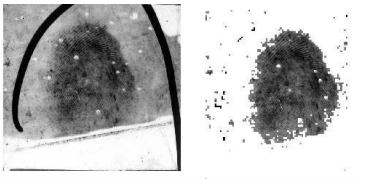 Latent fingerprints are fingerprints unintentionally left at a crime scene. Due to the poor quality and often complex image background and overlapping patterns characteristic of latent fingerprint images, separating the fingerprint region-of-interest from complex image background and overlapping patterns was a very challenging problem. Proposed is a latent fingerprint segmentation algorithm based on fractal dimension features and weighted extreme learning machine. Feature vectors were built from the local fractal dimension features and used as input to a weighted extreme learning machine ensemble classifier. The patches were classified into fingerprint and non- fingerprint classes. The experimental results of the proposed approach showed significant improvement in both the false detection rate (FDR) and overall segmentation accuracy compared to existing approaches.
Latent fingerprints are fingerprints unintentionally left at a crime scene. Due to the poor quality and often complex image background and overlapping patterns characteristic of latent fingerprint images, separating the fingerprint region-of-interest from complex image background and overlapping patterns was a very challenging problem. Proposed is a latent fingerprint segmentation algorithm based on fractal dimension features and weighted extreme learning machine. Feature vectors were built from the local fractal dimension features and used as input to a weighted extreme learning machine ensemble classifier. The patches were classified into fingerprint and non- fingerprint classes. The experimental results of the proposed approach showed significant improvement in both the false detection rate (FDR) and overall segmentation accuracy compared to existing approaches.
Predicting Models for Multibiometric Systems
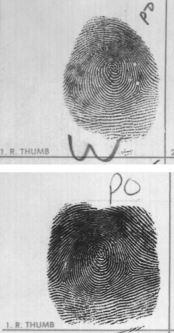 Recognizing a subject given a set of biometrics is a fundamental pattern recognition problem. We've
built novel statistical models for multibiometric systems using geometric and multinomial distributions.
These models are generic as they are only based on the similarity scores produced by a recognition
system. They predict the bounds on the range of indices within which a test subject is likely to be
present in a sorted set of similarity scores. These bounds are then used in the multibiometric recognition
system to predict a smaller subset of subjects from the database as probable candidates for a given test
subject. Experimental results show that the proposed models enhance the recognition rate beyond the
underlying matching algorithms for multiple face views, fingerprints, palm prints, irises and their
combinations.
Recognizing a subject given a set of biometrics is a fundamental pattern recognition problem. We've
built novel statistical models for multibiometric systems using geometric and multinomial distributions.
These models are generic as they are only based on the similarity scores produced by a recognition
system. They predict the bounds on the range of indices within which a test subject is likely to be
present in a sorted set of similarity scores. These bounds are then used in the multibiometric recognition
system to predict a smaller subset of subjects from the database as probable candidates for a given test
subject. Experimental results show that the proposed models enhance the recognition rate beyond the
underlying matching algorithms for multiple face views, fingerprints, palm prints, irises and their
combinations.
Prediction of Recognition Performance on Large Populations
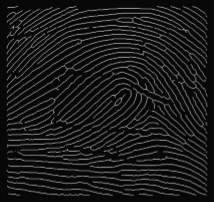 We have developed a procedure for the estimation of a small gallery size that can generate the optimal error
estimate and its confidence on a large population (relative to the size of the gallery). It uses a
generalized two-dimensional prediction model that combines a hypergeometric probability distribution
model with a binomial model and also considers the data distortion problem in large populations.
Learning is incorporated in the prediction process in order to find the optimal small gallery size and
to improve the prediction. The Chernoff and Chebychev inequalities are used as a guide to obtain the
small gallery size. Results for the prediction are presented for the NIST-4 fingerprint
database.
We have developed a procedure for the estimation of a small gallery size that can generate the optimal error
estimate and its confidence on a large population (relative to the size of the gallery). It uses a
generalized two-dimensional prediction model that combines a hypergeometric probability distribution
model with a binomial model and also considers the data distortion problem in large populations.
Learning is incorporated in the prediction process in order to find the optimal small gallery size and
to improve the prediction. The Chernoff and Chebychev inequalities are used as a guide to obtain the
small gallery size. Results for the prediction are presented for the NIST-4 fingerprint
database.
Predicting Fingerprint Biometrics Performance from a Small Gallery
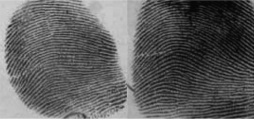 We present a binomial model to predict both fingerprint verification and identification performance.
The match and non-match scores are computed, using the number of corresponding triangles as the match
metric, between the query and gallery fingerprints.
The match score and non-match score in a binomial prediction model are used to predict the performance on
large (relative to the size of the gallery) populations from a small gallery.
We present a binomial model to predict both fingerprint verification and identification performance.
The match and non-match scores are computed, using the number of corresponding triangles as the match
metric, between the query and gallery fingerprints.
The match score and non-match score in a binomial prediction model are used to predict the performance on
large (relative to the size of the gallery) populations from a small gallery.
Fingerprint Matching Using Genetic Algorithms
.png) Fingerprint matching is still a challenging problem for reliable person authentication because of the complex distortions involved in two impressions of the same finger. In this paper, we propose a fingerprint-matching approach based on genetic algorithms (GA), which tries to find the optimal transformation between two different fingerprints. In order to deal with low-quality fingerprint images, which introduce significant occlusion and clutter of minutiae features, we design a fitness function based on the local properties of each triplet of minutiae. The experimental results on National Institute of Standards and Technology fingerprint database, NIST-4, not only show that the proposed approach can achieve good performance even when a large portion of fingerprints in the database are of poor quality, but also show that the proposed approach is better than another approach, which is based on mean-squared error estimation.
Fingerprint matching is still a challenging problem for reliable person authentication because of the complex distortions involved in two impressions of the same finger. In this paper, we propose a fingerprint-matching approach based on genetic algorithms (GA), which tries to find the optimal transformation between two different fingerprints. In order to deal with low-quality fingerprint images, which introduce significant occlusion and clutter of minutiae features, we design a fitness function based on the local properties of each triplet of minutiae. The experimental results on National Institute of Standards and Technology fingerprint database, NIST-4, not only show that the proposed approach can achieve good performance even when a large portion of fingerprints in the database are of poor quality, but also show that the proposed approach is better than another approach, which is based on mean-squared error estimation.
Fingerprint Classification Based on Learned Features
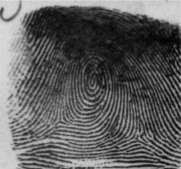 We introduce a fingerprint classification approach based on a novel feature-learning algorithm.
Unlike current research for fingerprint classification that generally uses well defined meaningful features,
our approach is based on Genetic Programming (GP), which learns to discover composite operators and
features that are evolved from combinations of primitive image processing operations. Our experimental
results show that our approach can find good composite operators to effectively extract useful features.
We introduce a fingerprint classification approach based on a novel feature-learning algorithm.
Unlike current research for fingerprint classification that generally uses well defined meaningful features,
our approach is based on Genetic Programming (GP), which learns to discover composite operators and
features that are evolved from combinations of primitive image processing operations. Our experimental
results show that our approach can find good composite operators to effectively extract useful features.
Prediction and Validation of Indexing Performance for Biometrics
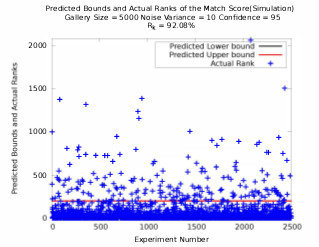 The performance of a recognition system is usually experimentally
determined. Therefore, one cannot predict the
peiformance of a recognition system a priori for a new
dataset. In this paper, a statistical model to predict the
value of k in the rank-k identification rate for a given biometric
system is presented. Thus, one needs to search only
the topmost k match scores to locate the true match object.
A geometrical probability distribution is used to model the
number of non match scores present in the set of similarity
scores. The model is tested in simulation and by using
a public dataset. The model is also indirectly validated
against the previously published results. The actual results
obtained using publicly available database are very close
to the predicted results which validates the proposed model.
The performance of a recognition system is usually experimentally
determined. Therefore, one cannot predict the
peiformance of a recognition system a priori for a new
dataset. In this paper, a statistical model to predict the
value of k in the rank-k identification rate for a given biometric
system is presented. Thus, one needs to search only
the topmost k match scores to locate the true match object.
A geometrical probability distribution is used to model the
number of non match scores present in the set of similarity
scores. The model is tested in simulation and by using
a public dataset. The model is also indirectly validated
against the previously published results. The actual results
obtained using publicly available database are very close
to the predicted results which validates the proposed model.
Predicting Fingerprint Recognition Performance from a Small Gallery
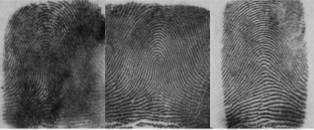 Predicting performance of biometrics is an important problem in a real world application.
We present a binomial model to predict fingerprint recognition performance. We use a
fingerprint identification algorithm to find the number of corresponding triangles as the match and
non-match scores. Then we use these similarity scores in a binomial prediction model, which uses
small gallery to predict performance on a large population. The results on the entire NIST-4 database
show that our model can reasonably predict large population performance.
Predicting performance of biometrics is an important problem in a real world application.
We present a binomial model to predict fingerprint recognition performance. We use a
fingerprint identification algorithm to find the number of corresponding triangles as the match and
non-match scores. Then we use these similarity scores in a binomial prediction model, which uses
small gallery to predict performance on a large population. The results on the entire NIST-4 database
show that our model can reasonably predict large population performance.
Fingerprint Indexing Based on Novel Features of Minutiae Triplets
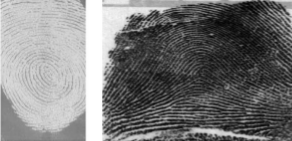 We present a model-based approach for fingerprints which efficiently retrieves correct hypotheses using
novel features of triangles formed by the triplets of minutiae as the basic representation unit. The triangle
features that we use are its angles, handedness, type, direction, and maximum side. Experimental results
on live-scan fingerprint images of varying quality and NIST special database 4 (NIST-4) show that our indexing
approach efficiently narrows down the number of candidate hypotheses in the presence of translation, rotation,
scale, shear, occlusion, and clutter.
We present a model-based approach for fingerprints which efficiently retrieves correct hypotheses using
novel features of triangles formed by the triplets of minutiae as the basic representation unit. The triangle
features that we use are its angles, handedness, type, direction, and maximum side. Experimental results
on live-scan fingerprint images of varying quality and NIST special database 4 (NIST-4) show that our indexing
approach efficiently narrows down the number of candidate hypotheses in the presence of translation, rotation,
scale, shear, occlusion, and clutter.
A Robust Two Step Approach for Fingerprint Identification
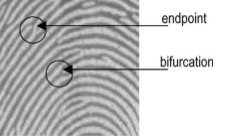 Due to the complex distortions involved in two impressions of the same finger, fingerprint identification
is still a challenging problem. We propose a two step fingerprint identification approach based
on the triplets of minutiae. The
experimental results on National Institute of Standards and Technology special fingerprint database 4, NIST-4,
show that the proposed approach provides a reduction by a factor of 10 for the number of the hypotheses
that need to be considered if linear search is used and can achieve a good performance even when a large
portion of fingerprints in the database are of poor quality.
Due to the complex distortions involved in two impressions of the same finger, fingerprint identification
is still a challenging problem. We propose a two step fingerprint identification approach based
on the triplets of minutiae. The
experimental results on National Institute of Standards and Technology special fingerprint database 4, NIST-4,
show that the proposed approach provides a reduction by a factor of 10 for the number of the hypotheses
that need to be considered if linear search is used and can achieve a good performance even when a large
portion of fingerprints in the database are of poor quality.
Fingerprint Identification: Classification vs. Indexing
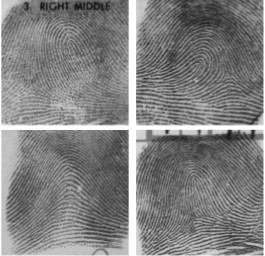 We present a comparison of two key
approaches for fingerprint identification. These approaches are
based on (a) classification followed by verification, and (b)
indexing followed by verification. The fingerprint classification
approach is based on a novel feature-learning algorithm. It
learns to discover composite operators and features that are
evolved from combinations of primitive image processing
operations. These features are then used for classification of
fingerprint into five classes. The indexing approach is based on
novel triplets of minutiae. The verification algorithm based on
Least Square Minimization over each of the possible triplets
minutiae pair is used for identification in both cases. On the
NIST-4 fingerprint database, the comparison shows that,
although correct classification rate can be as high as 92.8% for
5-class problems, the indexing approach performs better based
on size of search space and identification results.
We present a comparison of two key
approaches for fingerprint identification. These approaches are
based on (a) classification followed by verification, and (b)
indexing followed by verification. The fingerprint classification
approach is based on a novel feature-learning algorithm. It
learns to discover composite operators and features that are
evolved from combinations of primitive image processing
operations. These features are then used for classification of
fingerprint into five classes. The indexing approach is based on
novel triplets of minutiae. The verification algorithm based on
Least Square Minimization over each of the possible triplets
minutiae pair is used for identification in both cases. On the
NIST-4 fingerprint database, the comparison shows that,
although correct classification rate can be as high as 92.8% for
5-class problems, the indexing approach performs better based
on size of search space and identification results.
Learning Features for Fingerprint Classification
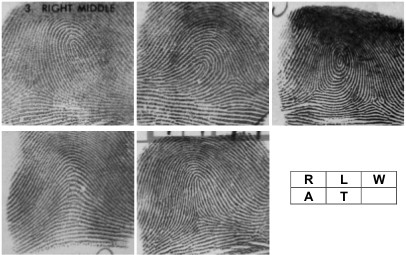 We present a fingerprint classification approach based
on a novel feature-learning algorithm. Unlike current research for fingerprint
classification that generally uses visually meaningful features, our approach is
based on Genetic Programming (GP), which learns to discover composite operators
and features that are evolved from combinations of primitive image
processing operations. Our experimental results show that our approach can
find good composite operators to effectively extract useful features. Using a
Bayesian classifier, without rejecting any fingerprints from NIST-4, the correct
rates for 4 and 5-class classification are 93.2% and 91.2% respectively, which
compare favorably and have advantages over the best results published to date.
We present a fingerprint classification approach based
on a novel feature-learning algorithm. Unlike current research for fingerprint
classification that generally uses visually meaningful features, our approach is
based on Genetic Programming (GP), which learns to discover composite operators
and features that are evolved from combinations of primitive image
processing operations. Our experimental results show that our approach can
find good composite operators to effectively extract useful features. Using a
Bayesian classifier, without rejecting any fingerprints from NIST-4, the correct
rates for 4 and 5-class classification are 93.2% and 91.2% respectively, which
compare favorably and have advantages over the best results published to date.
On The Fundamental Performance For Fingerprint Matching
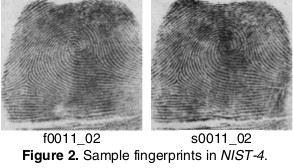 Fingerprints have long been used for person
authentication. However, there is not enough scientific
research to explain the probability that two fingerprints,
which are impressions of different fingers, may be taken
as the same one. We propose a formal
framework to estimate the fundamental algorithm
independent error rate of fingerprint matching. Unlike a
previous work, which assumes that there is no overlap
between any two minutiae uncertainty areas and only
measures minutiae’s positions and orientations, in our
model, we do not make this assumption and measure the
relations, i.e. ridge counts, between different minutiae as
well as minutiae’s positions and orientations. The error
rates of fingerprint matching obtained by our approach
are significantly lower than that of previously published
research. Results are shown using NIST-4 fingerprint
database. These results contribute towards making
fingerprint matching a science and settling the legal
challenges to fingerprints.
Fingerprints have long been used for person
authentication. However, there is not enough scientific
research to explain the probability that two fingerprints,
which are impressions of different fingers, may be taken
as the same one. We propose a formal
framework to estimate the fundamental algorithm
independent error rate of fingerprint matching. Unlike a
previous work, which assumes that there is no overlap
between any two minutiae uncertainty areas and only
measures minutiae’s positions and orientations, in our
model, we do not make this assumption and measure the
relations, i.e. ridge counts, between different minutiae as
well as minutiae’s positions and orientations. The error
rates of fingerprint matching obtained by our approach
are significantly lower than that of previously published
research. Results are shown using NIST-4 fingerprint
database. These results contribute towards making
fingerprint matching a science and settling the legal
challenges to fingerprints.
Fingerprint Matching by Genetic Algorithms
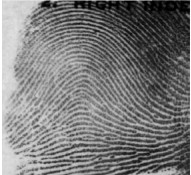 Fingerprint matching is still a challenging problem for reliable person authentication because of the
complex distortions involved in two impressions of the same finger. We propose a fingerprint
matching approach based on Genetic Algorithms (GA), which finds the optimal global transformation
between two different fingerprints. In order to deal with low quality fingerprint images, which introduce
significant occlusion and clutter of minutiae features, we de-sign the fitness function based on the local
properties of each triplet of minutiae. The experimental results on National Institute of Standards and
Technology fingerprint database, NIST-4, not only show that the proposed approach can achieve good
performance even when a large portion of fingerprints in the database are of poor quality, but also show
that the proposed approach is better than another approach, which is based on mean-squared
error estimation.
Fingerprint matching is still a challenging problem for reliable person authentication because of the
complex distortions involved in two impressions of the same finger. We propose a fingerprint
matching approach based on Genetic Algorithms (GA), which finds the optimal global transformation
between two different fingerprints. In order to deal with low quality fingerprint images, which introduce
significant occlusion and clutter of minutiae features, we de-sign the fitness function based on the local
properties of each triplet of minutiae. The experimental results on National Institute of Standards and
Technology fingerprint database, NIST-4, not only show that the proposed approach can achieve good
performance even when a large portion of fingerprints in the database are of poor quality, but also show
that the proposed approach is better than another approach, which is based on mean-squared
error estimation.
Fingerprint Verification Using Genetic Algorithms
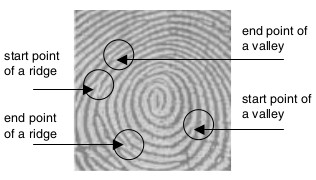 Fingerprint matching is still a challenging problem for
reliable person authentication because of the complex
distortions involved in two impressions of the same finger.
We propose a fingerprint matching
approach based on Genetic Algorithms (GA), which finds
the optimal global transformation between two different
fingerprints. In order to deal with low quality fingerprint
images, which introduce significant occlusion and clutter
of minutiae features, we design the fitness function based
on the local properties of each triplet of minutiae. The
experimental results on National Institute of Standards
and Technology fingerprint database, NIST-4, not only
show that the proposed approach can achieve good
performance even when a large portion of fingerprints in
the database are of poor quality, but also show that the
proposed approach is better than another approach,
which is based on mean-squared error estimation.
Fingerprint matching is still a challenging problem for
reliable person authentication because of the complex
distortions involved in two impressions of the same finger.
We propose a fingerprint matching
approach based on Genetic Algorithms (GA), which finds
the optimal global transformation between two different
fingerprints. In order to deal with low quality fingerprint
images, which introduce significant occlusion and clutter
of minutiae features, we design the fitness function based
on the local properties of each triplet of minutiae. The
experimental results on National Institute of Standards
and Technology fingerprint database, NIST-4, not only
show that the proposed approach can achieve good
performance even when a large portion of fingerprints in
the database are of poor quality, but also show that the
proposed approach is better than another approach,
which is based on mean-squared error estimation.
Robust Fingerprint Identification
.png) In this paper, we propose a fingerprint identification approach based on the triplets of minutiae. The features that we use to find the potential corresponding triangles include angles, triangle orientation, triangle direction, maximum side, minutiae density and ridge counts. False corresponding triangles are eliminated by applying constraints to the transformation between two potential corresponding triangles. The experimental results on National Institute of Standards and Technology special fingerprint database 4, NIST-4, show that, as compared to the linear search, the proposed approach provides a reduction by a factor of 200 for the number of the hypotheses that need to be considered and it can achieve good performance even when a large portion of fingerprints in the database are of poor quality
In this paper, we propose a fingerprint identification approach based on the triplets of minutiae. The features that we use to find the potential corresponding triangles include angles, triangle orientation, triangle direction, maximum side, minutiae density and ridge counts. False corresponding triangles are eliminated by applying constraints to the transformation between two potential corresponding triangles. The experimental results on National Institute of Standards and Technology special fingerprint database 4, NIST-4, show that, as compared to the linear search, the proposed approach provides a reduction by a factor of 200 for the number of the hypotheses that need to be considered and it can achieve good performance even when a large portion of fingerprints in the database are of poor quality
Learned templates for feature extraction in fingerprint images
.png) Most current techniques for minutiae extraction in fingerprint images utilize complex preprocessing and postprocessing. In this paper, we propose a new technique, based on the use of learned templates, which statistically characterize the minutiae. Templates are learned from examples by optimizing a criterion function using Lagrange's method. To detect the presence of minutiae in test images, templates are applied with appropriate orientations to the binary image only at selected potential minutia locations. Several performance measures, which evaluate the quality and quantity of extracted features and their impact on identification, are used to evaluate the signi3cance of learned templates. The performance of the proposed approach is evaluated on two sets of fingerprint images: one is collected by an optical scanner and the other one is chosen from NIST special fingerprint database 4. The experimental results show that learned templates can improve both the features and the performance of the identification system.
Most current techniques for minutiae extraction in fingerprint images utilize complex preprocessing and postprocessing. In this paper, we propose a new technique, based on the use of learned templates, which statistically characterize the minutiae. Templates are learned from examples by optimizing a criterion function using Lagrange's method. To detect the presence of minutiae in test images, templates are applied with appropriate orientations to the binary image only at selected potential minutia locations. Several performance measures, which evaluate the quality and quantity of extracted features and their impact on identification, are used to evaluate the signi3cance of learned templates. The performance of the proposed approach is evaluated on two sets of fingerprint images: one is collected by an optical scanner and the other one is chosen from NIST special fingerprint database 4. The experimental results show that learned templates can improve both the features and the performance of the identification system.
A triplet based approach for indexing of fingerprint database for identification
.png) This paper presents a model-based approach, which efficiently retrieves correct hypotheses using properties of triangles formed by the triplets of minutiae as the basic representation unit. We show that the uncertainty of minutiae locations associated with feature extraction and shear does not affect the angles of a triangle arbitrarily. Geometric constraints based on characteristics of minutiae are used to eliminate erroneous correspondences. We present an analysis to characterize the discriminating power of our indexing approach. Experimental results on fingerprint images of varying quality show that our approach efficiently narrows down the number of candidate hypotheses in the presence of translation, rotation, scale, shear, occlusion and clutter.
This paper presents a model-based approach, which efficiently retrieves correct hypotheses using properties of triangles formed by the triplets of minutiae as the basic representation unit. We show that the uncertainty of minutiae locations associated with feature extraction and shear does not affect the angles of a triangle arbitrarily. Geometric constraints based on characteristics of minutiae are used to eliminate erroneous correspondences. We present an analysis to characterize the discriminating power of our indexing approach. Experimental results on fingerprint images of varying quality show that our approach efficiently narrows down the number of candidate hypotheses in the presence of translation, rotation, scale, shear, occlusion and clutter.
Logical Templates for Feature Extraction in Fingerprint Images
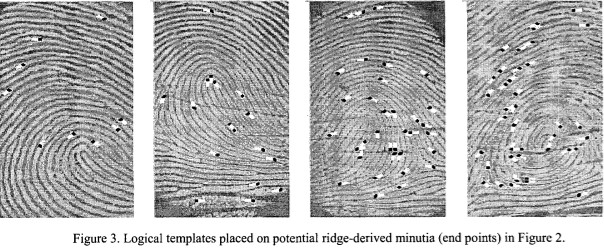 We present a novel approach for extraction of
minutiae features from fingerprint images. The proposed
approach is based on the use of logical templates for
minutiae extraction in the presence of data distortion. A
logical template is an expression that is applied to the
binary ridge (valley) image at selected potential
locations to detect the presence of minutia at these
locations. It is adapted to local ridge orientation and
frequency. We discuss the proposed technique in detail,
and present experimental results on low-resolution
images of various qualities.
We present a novel approach for extraction of
minutiae features from fingerprint images. The proposed
approach is based on the use of logical templates for
minutiae extraction in the presence of data distortion. A
logical template is an expression that is applied to the
binary ridge (valley) image at selected potential
locations to detect the presence of minutia at these
locations. It is adapted to local ridge orientation and
frequency. We discuss the proposed technique in detail,
and present experimental results on low-resolution
images of various qualities.
|


.png) This paper presents an approach for matching latent to rolled fingerprints using the (a) similarity of learned representations of patches and (b) the minutiae on the correlated patches. A deep learning network is used to learn optimized representations of image patches. Similarity scores between patches from the latent and reference fingerprints are determined using a distance metric learned with a convolutional neural network. The matching score is obtained by fusing the patch and minutiae similarity scores.
This paper presents an approach for matching latent to rolled fingerprints using the (a) similarity of learned representations of patches and (b) the minutiae on the correlated patches. A deep learning network is used to learn optimized representations of image patches. Similarity scores between patches from the latent and reference fingerprints are determined using a distance metric learned with a convolutional neural network. The matching score is obtained by fusing the patch and minutiae similarity scores.
.png) Latent fingerprints are fingerprint impressions unintentionally left on surfaces at a crime scene. They are crucial in crime scene investigations for making identifications or exclusions of suspects. Determining the quality of latent fingerprint images is crucial to the effectiveness and reliability of matching algorithms. To alleviate the inconsistency and subjectivity inherent in feature markups by latent fingerprint examiners, automatic processing of latent fingerprints is imperative. We propose a deep neural network that predicts the quality of image patches extracted from a latent fingerprint and knits them together to predict the quality of a given latent fingerprint.
Latent fingerprints are fingerprint impressions unintentionally left on surfaces at a crime scene. They are crucial in crime scene investigations for making identifications or exclusions of suspects. Determining the quality of latent fingerprint images is crucial to the effectiveness and reliability of matching algorithms. To alleviate the inconsistency and subjectivity inherent in feature markups by latent fingerprint examiners, automatic processing of latent fingerprints is imperative. We propose a deep neural network that predicts the quality of image patches extracted from a latent fingerprint and knits them together to predict the quality of a given latent fingerprint.
.png) Liveness detection is an anti-spoofing technique for dealing with presentation attacks on biometrics authentication systems. Since biometrics are usually visible to everyone, they can be easily captured by a malignant user and replicated to steal someone’s identity. In this paper, the classical binary classification formulation (live/fake) is substituted by a deep metric learning framework that can generate a representation of real and artificial fingerprints and explicitly models the underlying factors that explain their interand intra-class variations. The framework is based on a deep triplet network architecture and consists of a variation of the original triplet loss function. Experiments show that the approach can perform liveness detection in real-time outperforming the state-of-the-art on several benchmark datasets.
Liveness detection is an anti-spoofing technique for dealing with presentation attacks on biometrics authentication systems. Since biometrics are usually visible to everyone, they can be easily captured by a malignant user and replicated to steal someone’s identity. In this paper, the classical binary classification formulation (live/fake) is substituted by a deep metric learning framework that can generate a representation of real and artificial fingerprints and explicitly models the underlying factors that explain their interand intra-class variations. The framework is based on a deep triplet network architecture and consists of a variation of the original triplet loss function. Experiments show that the approach can perform liveness detection in real-time outperforming the state-of-the-art on several benchmark datasets.
 Latent fingerprints are fingerprints unintentionally left at a crime scene. Due to the poor quality and often complex image background and overlapping patterns characteristic of latent fingerprint images, separating the fingerprint region-of-interest from complex image background and overlapping patterns was a very challenging problem. Proposed is a latent fingerprint segmentation algorithm based on fractal dimension features and weighted extreme learning machine. Feature vectors were built from the local fractal dimension features and used as input to a weighted extreme learning machine ensemble classifier. The patches were classified into fingerprint and non- fingerprint classes. The experimental results of the proposed approach showed significant improvement in both the false detection rate (FDR) and overall segmentation accuracy compared to existing approaches.
Latent fingerprints are fingerprints unintentionally left at a crime scene. Due to the poor quality and often complex image background and overlapping patterns characteristic of latent fingerprint images, separating the fingerprint region-of-interest from complex image background and overlapping patterns was a very challenging problem. Proposed is a latent fingerprint segmentation algorithm based on fractal dimension features and weighted extreme learning machine. Feature vectors were built from the local fractal dimension features and used as input to a weighted extreme learning machine ensemble classifier. The patches were classified into fingerprint and non- fingerprint classes. The experimental results of the proposed approach showed significant improvement in both the false detection rate (FDR) and overall segmentation accuracy compared to existing approaches.
 We have developed a procedure for the estimation of a small gallery size that can generate the optimal error
estimate and its confidence on a large population (relative to the size of the gallery). It uses a
generalized two-dimensional prediction model that combines a hypergeometric probability distribution
model with a binomial model and also considers the data distortion problem in large populations.
Learning is incorporated in the prediction process in order to find the optimal small gallery size and
to improve the prediction. The Chernoff and Chebychev inequalities are used as a guide to obtain the
small gallery size. Results for the prediction are presented for the NIST-4 fingerprint
database.
We have developed a procedure for the estimation of a small gallery size that can generate the optimal error
estimate and its confidence on a large population (relative to the size of the gallery). It uses a
generalized two-dimensional prediction model that combines a hypergeometric probability distribution
model with a binomial model and also considers the data distortion problem in large populations.
Learning is incorporated in the prediction process in order to find the optimal small gallery size and
to improve the prediction. The Chernoff and Chebychev inequalities are used as a guide to obtain the
small gallery size. Results for the prediction are presented for the NIST-4 fingerprint
database.
 We present a binomial model to predict both fingerprint verification and identification performance.
The match and non-match scores are computed, using the number of corresponding triangles as the match
metric, between the query and gallery fingerprints.
The match score and non-match score in a binomial prediction model are used to predict the performance on
large (relative to the size of the gallery) populations from a small gallery.
We present a binomial model to predict both fingerprint verification and identification performance.
The match and non-match scores are computed, using the number of corresponding triangles as the match
metric, between the query and gallery fingerprints.
The match score and non-match score in a binomial prediction model are used to predict the performance on
large (relative to the size of the gallery) populations from a small gallery.
.png) Fingerprint matching is still a challenging problem for reliable person authentication because of the complex distortions involved in two impressions of the same finger. In this paper, we propose a fingerprint-matching approach based on genetic algorithms (GA), which tries to find the optimal transformation between two different fingerprints. In order to deal with low-quality fingerprint images, which introduce significant occlusion and clutter of minutiae features, we design a fitness function based on the local properties of each triplet of minutiae. The experimental results on National Institute of Standards and Technology fingerprint database, NIST-4, not only show that the proposed approach can achieve good performance even when a large portion of fingerprints in the database are of poor quality, but also show that the proposed approach is better than another approach, which is based on mean-squared error estimation.
Fingerprint matching is still a challenging problem for reliable person authentication because of the complex distortions involved in two impressions of the same finger. In this paper, we propose a fingerprint-matching approach based on genetic algorithms (GA), which tries to find the optimal transformation between two different fingerprints. In order to deal with low-quality fingerprint images, which introduce significant occlusion and clutter of minutiae features, we design a fitness function based on the local properties of each triplet of minutiae. The experimental results on National Institute of Standards and Technology fingerprint database, NIST-4, not only show that the proposed approach can achieve good performance even when a large portion of fingerprints in the database are of poor quality, but also show that the proposed approach is better than another approach, which is based on mean-squared error estimation.
 We introduce a fingerprint classification approach based on a novel feature-learning algorithm.
Unlike current research for fingerprint classification that generally uses well defined meaningful features,
our approach is based on Genetic Programming (GP), which learns to discover composite operators and
features that are evolved from combinations of primitive image processing operations. Our experimental
results show that our approach can find good composite operators to effectively extract useful features.
We introduce a fingerprint classification approach based on a novel feature-learning algorithm.
Unlike current research for fingerprint classification that generally uses well defined meaningful features,
our approach is based on Genetic Programming (GP), which learns to discover composite operators and
features that are evolved from combinations of primitive image processing operations. Our experimental
results show that our approach can find good composite operators to effectively extract useful features.
 The performance of a recognition system is usually experimentally
determined. Therefore, one cannot predict the
peiformance of a recognition system a priori for a new
dataset. In this paper, a statistical model to predict the
value of k in the rank-k identification rate for a given biometric
system is presented. Thus, one needs to search only
the topmost k match scores to locate the true match object.
A geometrical probability distribution is used to model the
number of non match scores present in the set of similarity
scores. The model is tested in simulation and by using
a public dataset. The model is also indirectly validated
against the previously published results. The actual results
obtained using publicly available database are very close
to the predicted results which validates the proposed model.
The performance of a recognition system is usually experimentally
determined. Therefore, one cannot predict the
peiformance of a recognition system a priori for a new
dataset. In this paper, a statistical model to predict the
value of k in the rank-k identification rate for a given biometric
system is presented. Thus, one needs to search only
the topmost k match scores to locate the true match object.
A geometrical probability distribution is used to model the
number of non match scores present in the set of similarity
scores. The model is tested in simulation and by using
a public dataset. The model is also indirectly validated
against the previously published results. The actual results
obtained using publicly available database are very close
to the predicted results which validates the proposed model.
 Predicting performance of biometrics is an important problem in a real world application.
We present a binomial model to predict fingerprint recognition performance. We use a
fingerprint identification algorithm to find the number of corresponding triangles as the match and
non-match scores. Then we use these similarity scores in a binomial prediction model, which uses
small gallery to predict performance on a large population. The results on the entire NIST-4 database
show that our model can reasonably predict large population performance.
Predicting performance of biometrics is an important problem in a real world application.
We present a binomial model to predict fingerprint recognition performance. We use a
fingerprint identification algorithm to find the number of corresponding triangles as the match and
non-match scores. Then we use these similarity scores in a binomial prediction model, which uses
small gallery to predict performance on a large population. The results on the entire NIST-4 database
show that our model can reasonably predict large population performance.
 We present a model-based approach for fingerprints which efficiently retrieves correct hypotheses using
novel features of triangles formed by the triplets of minutiae as the basic representation unit. The triangle
features that we use are its angles, handedness, type, direction, and maximum side. Experimental results
on live-scan fingerprint images of varying quality and NIST special database 4 (NIST-4) show that our indexing
approach efficiently narrows down the number of candidate hypotheses in the presence of translation, rotation,
scale, shear, occlusion, and clutter.
We present a model-based approach for fingerprints which efficiently retrieves correct hypotheses using
novel features of triangles formed by the triplets of minutiae as the basic representation unit. The triangle
features that we use are its angles, handedness, type, direction, and maximum side. Experimental results
on live-scan fingerprint images of varying quality and NIST special database 4 (NIST-4) show that our indexing
approach efficiently narrows down the number of candidate hypotheses in the presence of translation, rotation,
scale, shear, occlusion, and clutter.
 Due to the complex distortions involved in two impressions of the same finger, fingerprint identification
is still a challenging problem. We propose a two step fingerprint identification approach based
on the triplets of minutiae. The
experimental results on National Institute of Standards and Technology special fingerprint database 4, NIST-4,
show that the proposed approach provides a reduction by a factor of 10 for the number of the hypotheses
that need to be considered if linear search is used and can achieve a good performance even when a large
portion of fingerprints in the database are of poor quality.
Due to the complex distortions involved in two impressions of the same finger, fingerprint identification
is still a challenging problem. We propose a two step fingerprint identification approach based
on the triplets of minutiae. The
experimental results on National Institute of Standards and Technology special fingerprint database 4, NIST-4,
show that the proposed approach provides a reduction by a factor of 10 for the number of the hypotheses
that need to be considered if linear search is used and can achieve a good performance even when a large
portion of fingerprints in the database are of poor quality.
 We present a comparison of two key
approaches for fingerprint identification. These approaches are
based on (a) classification followed by verification, and (b)
indexing followed by verification. The fingerprint classification
approach is based on a novel feature-learning algorithm. It
learns to discover composite operators and features that are
evolved from combinations of primitive image processing
operations. These features are then used for classification of
fingerprint into five classes. The indexing approach is based on
novel triplets of minutiae. The verification algorithm based on
Least Square Minimization over each of the possible triplets
minutiae pair is used for identification in both cases. On the
NIST-4 fingerprint database, the comparison shows that,
although correct classification rate can be as high as 92.8% for
5-class problems, the indexing approach performs better based
on size of search space and identification results.
We present a comparison of two key
approaches for fingerprint identification. These approaches are
based on (a) classification followed by verification, and (b)
indexing followed by verification. The fingerprint classification
approach is based on a novel feature-learning algorithm. It
learns to discover composite operators and features that are
evolved from combinations of primitive image processing
operations. These features are then used for classification of
fingerprint into five classes. The indexing approach is based on
novel triplets of minutiae. The verification algorithm based on
Least Square Minimization over each of the possible triplets
minutiae pair is used for identification in both cases. On the
NIST-4 fingerprint database, the comparison shows that,
although correct classification rate can be as high as 92.8% for
5-class problems, the indexing approach performs better based
on size of search space and identification results.
 We present a fingerprint classification approach based
on a novel feature-learning algorithm. Unlike current research for fingerprint
classification that generally uses visually meaningful features, our approach is
based on Genetic Programming (GP), which learns to discover composite operators
and features that are evolved from combinations of primitive image
processing operations. Our experimental results show that our approach can
find good composite operators to effectively extract useful features. Using a
Bayesian classifier, without rejecting any fingerprints from NIST-4, the correct
rates for 4 and 5-class classification are 93.2% and 91.2% respectively, which
compare favorably and have advantages over the best results published to date.
We present a fingerprint classification approach based
on a novel feature-learning algorithm. Unlike current research for fingerprint
classification that generally uses visually meaningful features, our approach is
based on Genetic Programming (GP), which learns to discover composite operators
and features that are evolved from combinations of primitive image
processing operations. Our experimental results show that our approach can
find good composite operators to effectively extract useful features. Using a
Bayesian classifier, without rejecting any fingerprints from NIST-4, the correct
rates for 4 and 5-class classification are 93.2% and 91.2% respectively, which
compare favorably and have advantages over the best results published to date.
 Fingerprints have long been used for person
authentication. However, there is not enough scientific
research to explain the probability that two fingerprints,
which are impressions of different fingers, may be taken
as the same one. We propose a formal
framework to estimate the fundamental algorithm
independent error rate of fingerprint matching. Unlike a
previous work, which assumes that there is no overlap
between any two minutiae uncertainty areas and only
measures minutiae’s positions and orientations, in our
model, we do not make this assumption and measure the
relations, i.e. ridge counts, between different minutiae as
well as minutiae’s positions and orientations. The error
rates of fingerprint matching obtained by our approach
are significantly lower than that of previously published
research. Results are shown using NIST-4 fingerprint
database. These results contribute towards making
fingerprint matching a science and settling the legal
challenges to fingerprints.
Fingerprints have long been used for person
authentication. However, there is not enough scientific
research to explain the probability that two fingerprints,
which are impressions of different fingers, may be taken
as the same one. We propose a formal
framework to estimate the fundamental algorithm
independent error rate of fingerprint matching. Unlike a
previous work, which assumes that there is no overlap
between any two minutiae uncertainty areas and only
measures minutiae’s positions and orientations, in our
model, we do not make this assumption and measure the
relations, i.e. ridge counts, between different minutiae as
well as minutiae’s positions and orientations. The error
rates of fingerprint matching obtained by our approach
are significantly lower than that of previously published
research. Results are shown using NIST-4 fingerprint
database. These results contribute towards making
fingerprint matching a science and settling the legal
challenges to fingerprints.
 Fingerprint matching is still a challenging problem for reliable person authentication because of the
complex distortions involved in two impressions of the same finger. We propose a fingerprint
matching approach based on Genetic Algorithms (GA), which finds the optimal global transformation
between two different fingerprints. In order to deal with low quality fingerprint images, which introduce
significant occlusion and clutter of minutiae features, we de-sign the fitness function based on the local
properties of each triplet of minutiae. The experimental results on National Institute of Standards and
Technology fingerprint database, NIST-4, not only show that the proposed approach can achieve good
performance even when a large portion of fingerprints in the database are of poor quality, but also show
that the proposed approach is better than another approach, which is based on mean-squared
error estimation.
Fingerprint matching is still a challenging problem for reliable person authentication because of the
complex distortions involved in two impressions of the same finger. We propose a fingerprint
matching approach based on Genetic Algorithms (GA), which finds the optimal global transformation
between two different fingerprints. In order to deal with low quality fingerprint images, which introduce
significant occlusion and clutter of minutiae features, we de-sign the fitness function based on the local
properties of each triplet of minutiae. The experimental results on National Institute of Standards and
Technology fingerprint database, NIST-4, not only show that the proposed approach can achieve good
performance even when a large portion of fingerprints in the database are of poor quality, but also show
that the proposed approach is better than another approach, which is based on mean-squared
error estimation.
 Fingerprint matching is still a challenging problem for
reliable person authentication because of the complex
distortions involved in two impressions of the same finger.
We propose a fingerprint matching
approach based on Genetic Algorithms (GA), which finds
the optimal global transformation between two different
fingerprints. In order to deal with low quality fingerprint
images, which introduce significant occlusion and clutter
of minutiae features, we design the fitness function based
on the local properties of each triplet of minutiae. The
experimental results on National Institute of Standards
and Technology fingerprint database, NIST-4, not only
show that the proposed approach can achieve good
performance even when a large portion of fingerprints in
the database are of poor quality, but also show that the
proposed approach is better than another approach,
which is based on mean-squared error estimation.
Fingerprint matching is still a challenging problem for
reliable person authentication because of the complex
distortions involved in two impressions of the same finger.
We propose a fingerprint matching
approach based on Genetic Algorithms (GA), which finds
the optimal global transformation between two different
fingerprints. In order to deal with low quality fingerprint
images, which introduce significant occlusion and clutter
of minutiae features, we design the fitness function based
on the local properties of each triplet of minutiae. The
experimental results on National Institute of Standards
and Technology fingerprint database, NIST-4, not only
show that the proposed approach can achieve good
performance even when a large portion of fingerprints in
the database are of poor quality, but also show that the
proposed approach is better than another approach,
which is based on mean-squared error estimation.
.png) In this paper, we propose a fingerprint identification approach based on the triplets of minutiae. The features that we use to find the potential corresponding triangles include angles, triangle orientation, triangle direction, maximum side, minutiae density and ridge counts. False corresponding triangles are eliminated by applying constraints to the transformation between two potential corresponding triangles. The experimental results on National Institute of Standards and Technology special fingerprint database 4, NIST-4, show that, as compared to the linear search, the proposed approach provides a reduction by a factor of 200 for the number of the hypotheses that need to be considered and it can achieve good performance even when a large portion of fingerprints in the database are of poor quality
In this paper, we propose a fingerprint identification approach based on the triplets of minutiae. The features that we use to find the potential corresponding triangles include angles, triangle orientation, triangle direction, maximum side, minutiae density and ridge counts. False corresponding triangles are eliminated by applying constraints to the transformation between two potential corresponding triangles. The experimental results on National Institute of Standards and Technology special fingerprint database 4, NIST-4, show that, as compared to the linear search, the proposed approach provides a reduction by a factor of 200 for the number of the hypotheses that need to be considered and it can achieve good performance even when a large portion of fingerprints in the database are of poor quality
.png) Most current techniques for minutiae extraction in fingerprint images utilize complex preprocessing and postprocessing. In this paper, we propose a new technique, based on the use of learned templates, which statistically characterize the minutiae. Templates are learned from examples by optimizing a criterion function using Lagrange's method. To detect the presence of minutiae in test images, templates are applied with appropriate orientations to the binary image only at selected potential minutia locations. Several performance measures, which evaluate the quality and quantity of extracted features and their impact on identification, are used to evaluate the signi3cance of learned templates. The performance of the proposed approach is evaluated on two sets of fingerprint images: one is collected by an optical scanner and the other one is chosen from NIST special fingerprint database 4. The experimental results show that learned templates can improve both the features and the performance of the identification system.
Most current techniques for minutiae extraction in fingerprint images utilize complex preprocessing and postprocessing. In this paper, we propose a new technique, based on the use of learned templates, which statistically characterize the minutiae. Templates are learned from examples by optimizing a criterion function using Lagrange's method. To detect the presence of minutiae in test images, templates are applied with appropriate orientations to the binary image only at selected potential minutia locations. Several performance measures, which evaluate the quality and quantity of extracted features and their impact on identification, are used to evaluate the signi3cance of learned templates. The performance of the proposed approach is evaluated on two sets of fingerprint images: one is collected by an optical scanner and the other one is chosen from NIST special fingerprint database 4. The experimental results show that learned templates can improve both the features and the performance of the identification system.
.png) This paper presents a model-based approach, which efficiently retrieves correct hypotheses using properties of triangles formed by the triplets of minutiae as the basic representation unit. We show that the uncertainty of minutiae locations associated with feature extraction and shear does not affect the angles of a triangle arbitrarily. Geometric constraints based on characteristics of minutiae are used to eliminate erroneous correspondences. We present an analysis to characterize the discriminating power of our indexing approach. Experimental results on fingerprint images of varying quality show that our approach efficiently narrows down the number of candidate hypotheses in the presence of translation, rotation, scale, shear, occlusion and clutter.
This paper presents a model-based approach, which efficiently retrieves correct hypotheses using properties of triangles formed by the triplets of minutiae as the basic representation unit. We show that the uncertainty of minutiae locations associated with feature extraction and shear does not affect the angles of a triangle arbitrarily. Geometric constraints based on characteristics of minutiae are used to eliminate erroneous correspondences. We present an analysis to characterize the discriminating power of our indexing approach. Experimental results on fingerprint images of varying quality show that our approach efficiently narrows down the number of candidate hypotheses in the presence of translation, rotation, scale, shear, occlusion and clutter.
 We present a novel approach for extraction of
minutiae features from fingerprint images. The proposed
approach is based on the use of logical templates for
minutiae extraction in the presence of data distortion. A
logical template is an expression that is applied to the
binary ridge (valley) image at selected potential
locations to detect the presence of minutia at these
locations. It is adapted to local ridge orientation and
frequency. We discuss the proposed technique in detail,
and present experimental results on low-resolution
images of various qualities.
We present a novel approach for extraction of
minutiae features from fingerprint images. The proposed
approach is based on the use of logical templates for
minutiae extraction in the presence of data distortion. A
logical template is an expression that is applied to the
binary ridge (valley) image at selected potential
locations to detect the presence of minutia at these
locations. It is adapted to local ridge orientation and
frequency. We discuss the proposed technique in detail,
and present experimental results on low-resolution
images of various qualities.